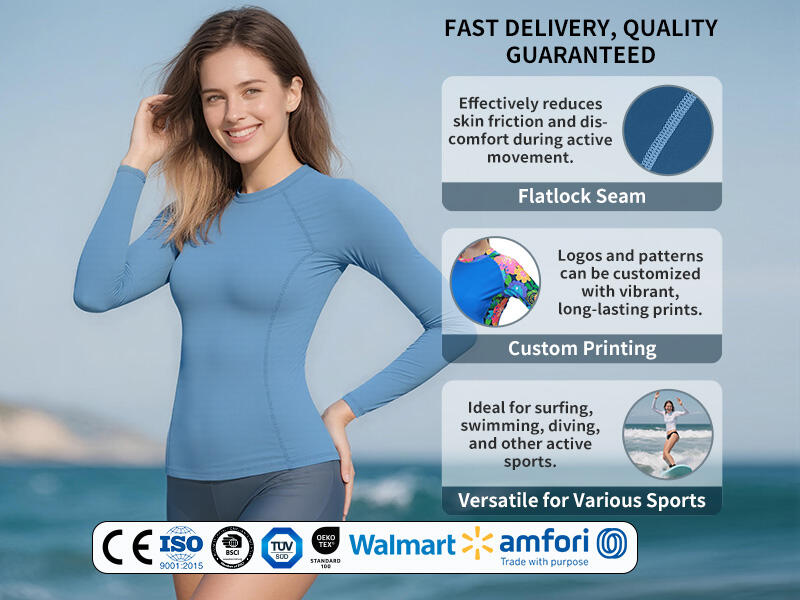Understanding the Dual Role of Rash Guards in Swimming and Surfing
What Is a Rash Guard and How Does It Support Multiple Water Activities?
Rash guards are those tight fitting shirts made from stretchy material that actually serve multiple purposes. They were first created back when surfers needed something to stop their skin from getting rubbed raw against surfboards, but now people wear them for all sorts of water activities too. Most modern versions come with UPF 50+ fabric which blocks almost all harmful UV rays, so anyone who spends time outdoors on the water should really consider getting one. The materials dry fast and the design helps reduce resistance in the water, which makes a big difference for competitive swimmers trying to shave seconds off their times. What makes these garments so great is how they handle both sun damage and scrapes while still letting the body move naturally, whether someone is diving deep underwater or just lounging around at the beach.
Comparing Rash Guard Use in Swimming vs. Surfing Environments
Swimmers tend to go for lighter fabrics since they want less drag in the water, while surfers need something much sturdier that can handle rubbing against boards and getting hit by waves all day long. For regular swimming stuff, rash guards usually have those flatlock seams that stop skin irritation from happening when doing stroke after stroke. But when it comes to surfing gear, manufacturers throw in way more spandex sometimes as much as 18% so surfers can move their arms freely without restriction. According to a recent survey conducted last year by various water safety organizations, around three quarters of surfers wear rash guards mainly because they help avoid injuries. Meanwhile most swimmers seem concerned about sun protection during their workouts, with nearly two thirds reporting this as their main reason for wearing one.
Design Differences Between Rashguards for Swimming and Rashguards for Surfing
Rash guards designed for swimming tend to have those slim fits with raglan sleeves because they help swimmers move better through the water. On the other hand, the ones made for surfing come with extra thick panels on the chest area and tighter hems around the bottom so they don't ride up when someone gets wiped out. Materials used for surfing gear generally feel heavier too, maybe about a quarter to a third heavier than regular swimwear stuff since they need to handle all that rubbing against surfboards covered in wax. Chlorine resistant fabric matters most for pool swimmers obviously, but surfers care more about how their rash guard holds up in saltwater conditions and stays warm enough when the ocean gets chilly later in the day.
Performance Benefits: Why Swimmers and Surfers Choose Rash Guards
Rash guards do more than just protect skin from abrasions. They actually boost performance too. Swimmers have seen around 2 to 4 percent better speed when wearing compression fit designs, and surfers tell us about roughly 30 percent fewer injuries related to their fins. The fabrics used wick away moisture so people don't get weighed down by waterlogged gear which causes fatigue. Plus there's something else going on these days with how they're made. Many brands now use recycled polyester blends that attract folks who care about the environment. An analysis of recent data from last year indicates that the majority of aquatic athletes reported increased endurance times during extended training sessions, whether in pool workouts or in open ocean conditions.
Key Protective Benefits of Rash Guards for Surfers
Preventing Rashes and Abrasions from Surfboard Contact
Rash guards create a vital protective barrier between surfers' skin and their boards. Made from smooth polyester-spandex blends, they significantly reduce friction and prevent abrasions caused by repeated contact with surfboard wax and saltwater. This protection is particularly crucial during extended paddling sessions where skin irritation commonly occurs.
UV Protection During Long Hours in the Sun: A Critical Benefit for Surfers
High-performance rash guards offer UPF 50+ sun protection, effectively blocking over 98% of harmful UV rays. This level of protection is especially important for surfers who spend hours under direct sunlight, where typical sunscreen can wash off quickly.
Material Resilience Under Constant Wave Exposure
Designed to endure harsh conditions, rash guards utilize durable materials like nylon-Lycra blends that resist saltwater corrosion, sand abrasion during wipeouts, and repetitive stretching from paddling motions. These fabrics maintain integrity through 8-10 hour surf sessions while retaining shape over multiple seasons.
Case Study: Professional Surfers Relying on Rash Guards in Competition
In professional surfing competitions, 94% of athletes wear rash guards according to 2023 World Surf League gear reports. Post-event medical evaluations show a 63% reduction in treated chest/arm abrasions compared to pre-rash guard era injury logs.
Rash Guards in Swimming: Functionality, Comfort, and Performance
Are Rash Guards Effective as Standalone Swimwear?
These days, modern rash guards work great as actual swimwear on their own, giving that snug fit similar to compression gear which helps cut down on water resistance without sacrificing protection. The best ones come with seamless construction so there's no rubbing against the skin, plus they use flatlock stitching that doesn't bother anyone when doing those long sets in the pool. According to a recent study back in 2023 looking at how well different swimwear performs, around 8 out of 10 competitive swimmers who wore UPF 50+ rash guards said they moved just as freely or even better than regular swimsuits. And about two thirds mentioned their skin felt less irritated after swimming in chlorinated pools, which is definitely something worth considering for anyone spending time in the water regularly.
Sun Protection and Rash Guards: Why Swimmers Choose Them
Swimmers get real benefits from built-in UV protection these days. Rash guards can block around 98% of those harmful UVA and UVB rays, making them way better at protecting skin than regular sunscreen which just washes off in the water. The tight weave of materials such as nylon mixed with polyester keeps working even after stretching, something that cheaper, looser fabrics simply cannot do because they tend to let sunlight through where threads separate. A study done by doctors at Columbia University's Dermatology Department back in 2023 found that people who wore rash guards while swimming outdoors experienced about 40 percent less sunburn compared to folks who only used sunscreen products. That kind of difference matters a lot for anyone spending time under the sun.
Hydrodynamics and Comfort: How Fabric Affects Swim Efficiency
Modern fabric technology manages both water movement and body heat control pretty well. Fabrics that stretch in all directions fit snugly against the body without losing shape, chlorine resistant materials keep their bounce even after hundreds of laundry cycles, and special surface treatments cut down on water soaking in by about a third compared to regular cotton mixes. When triathletes tested these new designs in 2024, they actually finished segments 1.2% quicker wearing rash guards than going sleeveless. The difference seems to come from less resistance in the water (the drag number dropped by 0.07 Cd) plus better management of internal body temps during long swims and runs.
Material, Fit, and Design: Engineering Rash Guards for Active Use
Common Fabric Materials and Their Performance Properties
Most modern rash guards mix about 80 to 85 percent nylon with around 15 to 20 percent spandex or elastane. This combination gives good UV protection without sacrificing movement. The fabric can handle UPF 50 plus ratings and still keep its shape even after being exposed to saltwater over 200 times. Recent testing in 2024 showed that polyester spandex blends actually dry about 30 percent quicker than regular cotton stuff. For swimmers who move from pools to open water, this makes a real difference in comfort and performance during transitions between different environments.
How Fit Influences Mobility in Swimming and Surfing
Compression fits (10-15% stretch) dominate surfing designs to minimize board friction, while swimming-focused rash guards use streamlined cuts to reduce drag. Studies show a 2-3mm variance in seam placement can alter shoulder rotation by 12°, directly impacting paddle and stroke efficiency in both activities.
Moisture-Wicking, Stretch, and Durability for Intense Water Use
High-performance fabrics wick 0.5 liters of moisture per hour-matching Olympic-level sweat rates-and elastic fibers maintain 90% stretch recovery after six months of saltwater use. In durability tests, these materials outperform standard swimwear by a 3:1 margin.
Balancing Tight Fit with Comfort During Prolonged Wear
Ergonomic paneling reduces underarm chafing by 40% compared to traditional designs. Flatlock seams prevent irritation during extended surf sessions while preserving the hydrodynamic profile preferred by competitive swimmers.
Beyond the Waves: Other Uses for Multifunctional Rash Guards
Rash Guards in Paddleboarding, Snorkeling, and Triathlons
Nylon and spandex mixes that keep surfers safe from board scrapes also give paddleboarders something solid to hold onto when waves get rough. Triathletes wear stuff that cuts through water better because their swims need to be fast, and snorkelers grab gear made to stand up against saltwater for hours on end. These days, most people are wearing clothes made from polyester and elastane combinations instead of older materials. They actually hold their shape way better too – around 40 or so percent improvement over what was used before for folks doing multiple sports throughout the day.
Wearing Rash Guards as Sun-Protective Clothing Outside the Water
A 2023 dermatological study found rash guards block 98% of UVB rays, outperforming standard sunscreen’s average 80% protection rate. Their UPF 50+ rating and breathable construction make them ideal for hiking, beach volleyball, and outdoor workouts. Unlike bulkier sun shirts, rash guards maintain full mobility and resist pilling from backpack straps.
Trend Analysis: Rising Demand for Versatile Rash Guards
Since 2021, the worldwide market for rash guards has been growing at around 22% per year, and most of that growth comes from people using them outside traditional surfing contexts. We're seeing some pretty interesting developments too - manufacturers are adding stuff like extra strong stitching for climbers and special fabric treatments that fight odors, so folks can wear these garments multiple days without issues. The demand is clearly there for protection against various risks beyond just waves. Retail stores tell us sales for land-based activities have shot up about three times what they were back in 2020. Looks like rash guards are becoming go-to items across all sorts of environments these days.
FAQ about Rash Guards
Q: What is a rash guard used for?
A: Rash guards are primarily used to prevent skin irritation and sunburn during water activities like surfing, swimming, and paddleboarding. They offer a protective barrier against abrasions and harmful UV rays.
Q: Why should swimmers wear rash guards?
A: Swimmers wear rash guards for sun protection, improved water performance by reducing drag, and enhanced skin protection in chlorinated pools.
Q: Can rash guards be worn outside of aquatic activities?
A: Yes, rash guards can be worn as sun-protective clothing for outdoor activities like hiking and volleyball due to their high UPF rating and breathable fabric.
Table of Contents
- Understanding the Dual Role of Rash Guards in Swimming and Surfing
- Key Protective Benefits of Rash Guards for Surfers
- Rash Guards in Swimming: Functionality, Comfort, and Performance
- Material, Fit, and Design: Engineering Rash Guards for Active Use
- Beyond the Waves: Other Uses for Multifunctional Rash Guards

